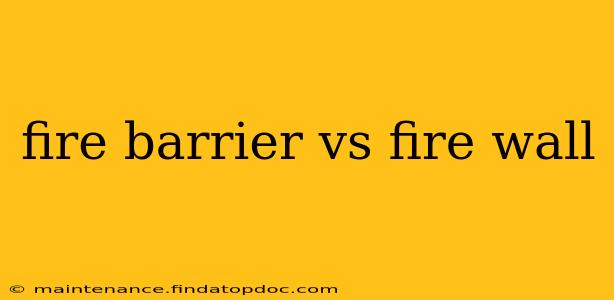The terms "fire barrier" and "firewall" are often used interchangeably, leading to confusion. While both relate to fire safety, they serve distinct purposes and have different applications. Understanding the core differences is crucial for ensuring appropriate fire protection in buildings. This article clarifies the distinction between fire barriers and firewalls, addressing common questions and misconceptions.
What is a Fire Barrier?
A fire barrier is a passive fire protection system designed to restrict the spread of fire and smoke within a building for a specified period. It's a physical barrier constructed of fire-resistant materials, effectively compartmentalizing a structure. This compartmentalization limits the extent of damage and allows for safe evacuation. Fire barriers can be comprised of various materials, including fire-rated drywall, concrete, masonry, and specialized fire-rated doors and glazing. Their effectiveness is measured by their fire resistance rating, usually expressed in hours (e.g., a 2-hour fire barrier).
The primary function of a fire barrier is to contain a fire within a specific area, preventing its spread to adjacent areas and improving the chances of occupant safety. They are crucial for dividing buildings into separate fire zones, thereby mitigating the risk of catastrophic damage and facilitating fire suppression efforts.
What is a Firewall?
A firewall, in the context of building construction, is a specific type of fire barrier with stricter requirements. It's a fire-resistant wall designed to prevent the spread of fire between different buildings or sections of a building that have separate ownership or occupancy. Think of it as a more robust and extensive fire barrier designed to create complete separation. Firewalls are often thicker and more heavily constructed than standard fire barriers, and they usually extend from the foundation to the roof, preventing flames from climbing over or around the barrier.
The primary goal of a firewall is to provide separation between distinct fire zones, protecting one structure or section from the potential impact of a fire in another. They play a critical role in preventing the rapid spread of large-scale fires and protecting life and property.
What are the Key Differences Between Fire Barriers and Firewalls?
The main distinctions lie in their scope, construction, and purpose:
- Scope: Fire barriers compartmentalize areas within a single building, while firewalls separate different buildings or distinct sections of a building under separate ownership or occupancy.
- Construction: Firewalls generally have more stringent construction requirements, being thicker and more robust than typical fire barriers. They often have higher fire resistance ratings.
- Purpose: Fire barriers aim to contain fire within a building, while firewalls aim to prevent fire spread between buildings or distinct, separate sections.
What materials are used to construct fire barriers and firewalls?
Both fire barriers and firewalls utilize fire-resistant materials, but the specific choice depends on the required fire resistance rating and the application. Common materials include:
- Concrete: Offers excellent fire resistance due to its high mass and thermal capacity.
- Masonry (brick, block): Another robust material providing good fire resistance, particularly when properly mortared.
- Fire-rated drywall (gypsum board): A common and versatile material, often used in conjunction with steel studs to create fire-rated partitions.
- Steel: Provides structural support and can be treated to enhance fire resistance.
How are fire barriers and firewalls tested and rated?
Fire barriers and firewalls are subjected to rigorous testing to determine their fire resistance rating. These tests simulate real-world fire conditions, measuring the time it takes for the barrier to fail under intense heat and flame exposure. The rating (e.g., 1-hour, 2-hour, 4-hour) indicates how long the barrier can withstand the fire conditions without compromising its integrity.
Are fire barriers and firewalls required by building codes?
Yes, building codes mandate the use of fire barriers and firewalls depending on the building's type, occupancy, size, and other factors. The specific requirements vary by jurisdiction and are based on risk assessment and life safety considerations. Consult local building codes and relevant regulations for specific requirements.
This detailed comparison clarifies the distinctions between fire barriers and firewalls, emphasizing the importance of understanding these crucial fire safety elements in building design and construction. Proper implementation of these systems is vital for protecting lives and property from fire hazards.
